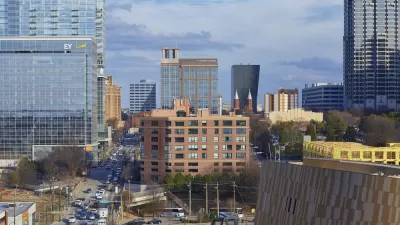Here are some observations that may shed light on the mystery of why—despite creating every incentive that planners can conceive—we are failing to produce affordable housing at the level we need.

It is often convenient to blame city planners for the affordable housing crisis. After all, those affected have no other public forum to vent their concerns, least of all toward those who are profiting off of the crisis on a project-by-project basis. Sadly, this blame is often misguided because planners do not produce housing.
A case study of the profit-maximizing, decision-making that is driving the affordability crisis is downtown San Diego. Construction cranes are up all over, and a $6.4 billion development juggernaut is rolling through. Nearly 10,000 new units have been permitted by the downtown planning board over the last four years, and the fast and generous permit approval process is cited as a model by developers for other regions. Underlying this process is a programmatic master plan that eliminates the need for project-level environmental review, lax standards on deviations from the zoning code, and a public hearing process that is limited to design review, often bypassing complex questions about density and community impacts. The process is overlaid with myriad incentives in the form of density bonuses for affordable housing and green building.
This kind of permit streamlining that supply-siders clamor for in state and local legislation for land-use planning and zoning reform is a developers’ dream come true. Yet, this same socially blind approach to planning has led to more affordable housing units being demolished than being built, and a 60 percent spike in unsheltered homeless downtown in the last two years.
FULL STORY: Making It Easier to Build Won’t Generate Affordable Units

Alabama: Trump Terminates Settlements for Black Communities Harmed By Raw Sewage
Trump deemed the landmark civil rights agreement “illegal DEI and environmental justice policy.”

Planetizen Federal Action Tracker
A weekly monitor of how Trump’s orders and actions are impacting planners and planning in America.

The 120 Year Old Tiny Home Villages That Sheltered San Francisco’s Earthquake Refugees
More than a century ago, San Francisco mobilized to house thousands of residents displaced by the 1906 earthquake. Could their strategy offer a model for the present?

Opinion: California’s SB 79 Would Improve Housing Affordability and Transit Access
A proposed bill would legalize transit-oriented development statewide.

Record Temperatures Prompt Push for Environmental Justice Bills
Nevada legislators are proposing laws that would mandate heat mitigation measures to protect residents from the impacts of extreme heat.

Downtown Pittsburgh Set to Gain 1,300 New Housing Units
Pittsburgh’s office buildings, many of which date back to the early 20th century, are prime candidates for conversion to housing.
Urban Design for Planners 1: Software Tools
This six-course series explores essential urban design concepts using open source software and equips planners with the tools they need to participate fully in the urban design process.
Planning for Universal Design
Learn the tools for implementing Universal Design in planning regulations.
Clanton & Associates, Inc.
Jessamine County Fiscal Court
Institute for Housing and Urban Development Studies (IHS)
City of Grandview
Harvard GSD Executive Education
Toledo-Lucas County Plan Commissions
Salt Lake City
NYU Wagner Graduate School of Public Service





























